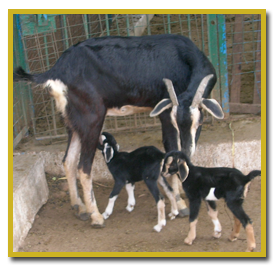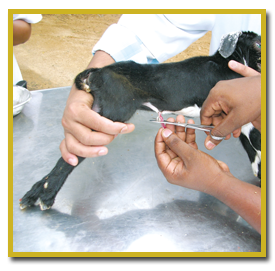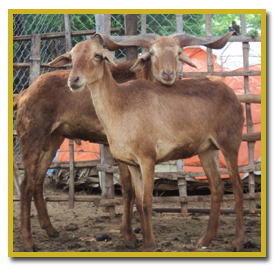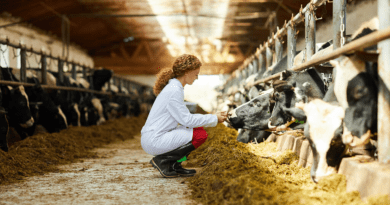Popular Breeds of Ruminant Animals
Generally, ruminant animals breed ranges from local breeds to exotic (imported) breeds. The local breed of cattle include: White Fulani, Ndama, Muturu, Sokoto Gudali, Zebu etc. while the exotic breeds include Holstein, Fresian, Brown Swiss, Jersey etc.
Breeds of Goat include: West African Dwarf Goat, West African Long-Legged Goat, Red Sokoto, Numibian, Sudan Desert and Sannen while Breeds of Sheep include: West African Dwarf Sheep, Ouda, Yankassa etc.
Points to be considered in the selection of ruminant animals for breeding
- It is better to purchase a goat/sheep with 2 dental ages.
- The females should possess a long preferably low set body, roomy hind quarter, well-formed pliable udder, active foraging habit and good mothering instinct.
- The females having poor milking capacity, over short or undershort jaw, broken mouth, blind teat and meaty udder should be disqualified from the breeding programme.
- Wide roomy hind quarter with good space between inner aspects of two thighs gives an indication about future development of udder.
- Male animals should be in good body condition, masculine, legs should be stronger and free from defects.
- Breeding male should show good libido.
- The animal should be having both testicle intact in the scrotum.
- It will be better, if the goats can be purchased from a best farm or from an individual farmer who maintained the goats in a best manner, instead of getting the goats from weekly shandies.
- Females having ability to yield 2 or 3 kids in parturition can be selected.
- Soft and shiny skinned goats should be selected and this indicates the health of the animal.
- Animals with broader back and rump regions will be better. Broad back and rib cages indicates that, goat having better feed intake capacity. Whereas broad rump region indicates better breeding characters.
- The female should have the maternal character of protecting her kid and with better milk feeding abilities.
- The female with well grown, blended udder should be selected.
- The udder should be thoroughly checked for any kind of defects before purchase.
- Breeding ewe of indigenous breeds should be 18to 24 months depending upon their body condition.
- Breeding too young ewes result in more weakling and thus results in higher lamb loss.
- As a guideline, females should be mated only when they reach 70 per cent of the average adult body weight.
- Body weight of an ewe at breeding should normally be less than the adult body weight of that breed.
- The libido of the ram is very important to achieve desirable breeding. Poor libido may result from inadequate feeding, extreme heat stress or ill-health.
Read Also: What is a dairy goat? What do dairy goats like to eat? Which goat gives more milk?
Reproductive parameters of ruminant animals like sheep and goat
- Breeding age- 6-8 months
- Comes to heat after lambing – 21 days after
- Length of pregnancy – 147 days (ranges between 144 and 152 days)
- Male female ratio – 1:20
- Estrous period is repeated every 16-17 days on average in ewes (range 14-19 days).
- Estrous period is 19-21 days in does (range 17-24 days).
- The estrous period lasts for about 24-36 hours in ewes and 34-38 hours in does.
Estrous signs of sheep and goat
 |
 |
- Redden of the vulva and discharge from vulva
- Tail wagging
- Mounting other animal
- Seeking male
- Frequent bleating
- Push her back
- Standing for mating (standing reflex)
The males are attracted by smell, sight and sound and exhibit following behaviour
- Sniff the vulva
- Extending neck with curling of upper lip
- Biting the side of the ewe/doe and wool pulling
- Paw the ewe– raising and lowering of one front leg in a stiff legged striking motion
- Mount and mate
Identification of ruminant animals like sheep and goat in heat
1. Using an intact male
- The male is allowed in the flock to identify the oestrous animals.
- There is a chance of the buck or ram will mate the doe or ewe if it is not controlled properly.
2. Use of intact male fitted with aprons
 |
| Male with aprons |
- An apron is tied on the abdomen of the male to cover the penis.
- The apron is made of a soft piece of cloth measuring 60×45 cm with strings on four sides to tie it properly. This prevents mating.
- The apron should be washed daily and checked for holes or tears to avoid unwanted mating.
- There is a risk of fertile mating if the apron is not securely fastened and checked frequently.
- Inflammation, irritation and infection of penis and prepuce area can occur, resulting in inhibited sexual desire and mounting behaviour.
- The ram/buck are apronized and allowed in to the flock for identification of animals in the morning and evening for about 15 to 20minutes.
- Teasure ram/buck detects the females in heat, which are marked and separated out for breeding with desired ram.
3. Vasactamised ram
- Vasactamised rams can be prepared by doing surgical intervention.
- An intact buck or ram is let in to the flock. The buck or ram follows the doe/ewe in estrous.
Preparation of Female
Flushing
Flushing
- Flushing is feeding of extra concentrate to ewes prior to onset of breeding season, normally 3 or 4 weeks before breeding.
- This increases the ovulation rate of ewes, so that the number of twins and triplets increase.
- In tropical flocks twining and triplets are rare and in extensive rearing twining and triplets are undesirable.
- Flushing will have effect only if the ewes were in declining phase of nutritional availability.
- Ewes in better body condition will produce more lambs thus the flushing of leaner ewes will increase the fertility by way of increasing incident of oestrous, increase ovulation rate and decreases the early embryonic mortality by strengthening the fetal membrane integrity.
- Flushing can be done by supplementing 250 g of concentrate daily or 500 g of good quality legume hay per head per day.
- Flushing increases the lambing rate by 10 to 20 per cent.
- In wooly breeds of sheep the following preparations are required.
Tagging
- Ewes sometimes are not bred because wool or tags prevent the ram from making satisfactory copulation, thus tagging makes service by the ram more certain.
- The ram is also trimmed around the sheath.
Eyeing
- To prevent wool blindness in some breeds the excess wool around the eyes should be clipped away regularly. This process is referred to as eyeing.
Ringing
- Before the breeding season starts the wools should be completely removed from all over the body of the ram.
- He should at least be clipped from the neck and from the belly particularly at the region of penis. This process is referred to as ringing.
- This process makes it easier for the ram to have proper mating.
Crutching
- Removal of wool around the perennial region and base of the tail of an ewe is known as crutching. This facilitates better mating.
- This refers shearing the lock of wool and dirt from the dock.
Read Also: How to identify poisoned ruminant animals and how to tackle it
Preparation of Male
Marking the ram / buck
- For the sake of identification of the ewe does which have been bred by the rams bucks, it is essential that rams bucks must have some cye in their breast, which at the time of mating will mark the particular ewes does (marked ewes does). For this either lamp black or Venetian red is mixed up with linseed oil to make a paste, which is then applied in the brisket area at least once a week.
- When the ram buck mounts the ewe doe during the course of breeding, she will be marked on the rump (marked).
- This makes it possible to record the date when the ewes doe are bred and also to remove them from the breeding flock.
- The colour of the dye should be changed every 16 to 18days so that the repeaters can be discovered, if the bred ewes does have not been removed from the flock.
- This process is termed as marking of ewes 1 does by breeding ram buck and marked ewes does considered as bred.
Raddle/raddling
- Marking of ewe by ram can also be done by raddle. Raddle is nothing but a ram harness containing crayon, which is rubbed on the ewe’s rump when mating takes place, so that a colour mark is left.
- The process of allowing the ram to run along with raddle is termed as raddling.
- The above practice can also be adopted in goats
Methods of mating
- 1. Hand mating
- In this system the females are allowed to mate one by one.
- In this system a ram or buck will not be allowed to mate more than three ewes/does in a day.
Merits
- This method ensure the expected time of lambing / kidding
- This system allows the farmer to know that the animal has actually bred.
- This system reduces the risk of injuries to the animals.
- It is beneficial when mating older male with a younger female.
- It also improves the breeding efficiency of male, resulting in an increased number of females that can be bred in shorter period of time.
2. Pen mating
- In this mating system the ewes/does are divided into batches varying from 20 to 25 ewes/does.
- Males are turned in to the flock only during the night time and separated during day time.
Merits
- This system of mating prevents the disturbances to the ewes/does by the male during grazing hours.
- Males are also given enough rest and they can be fed properly.
3. Flock mating/pasture mating
- In this system males are allowed to run along with the females throughout the day and night.
- The male may lose it most of its body reserves in chasing the females and they may lose their body conditions.
Demerits
- The ram or buck sometimes may develop attraction for particular ewe or doe in heat and serve it a number of times while other remains unattended resulting in empty ewes/does and low fertility rate.
- The ram/buck some time exhaust itself overnight by serving more than a dozen times and the last served ewes or does not receive optimum number of spermatozoa and remain unconceived.
4. Artificial insemination
- Artificial insemination offer the best means of distributing germplasm from nucleus breeding flock to many small flocks within each eco system.
- Fresh as well as frozen semen is used.
- The speculum method of insemination is used for ewes and does.
- Generally artificial insemination leads to lower reproductive rate than natural service and frozen semen gives even much low pregnancy rate that is around 40%.
- Cervical insemination is generally followed for better conception rate.
Read Also: Reasons why some Ruminant Animals cannot deliver by themselves and How you can help them
Care of pregnant ruminant animals
 |
- The pregnant animals ewes should not be handled frequently.
- The ewes/does in advanced stage of pregnancy should be separated from the flock and effective care should be taken in
their feeding. - Extra feed during the later part of pregnancy (3-4 weeks before parturition) will be beneficial for the condition of the pre-parturient ewes does which will help in improving milk production of ewes does and birth weight and growth of lambs/ kids.
- Inadequate and poor nutrition in pregnant animals may result in pregnancy toxaemia, abortion and premature birth of weak lambs / kids.
- Ewe/ doe in advanced stage of pregnancy should be kept in a separate lambing corals or shed 4-6 days before partition and maximum comfort like soft clean bedding and individual lambing pen should be provided.
- The pregnant ewe/doe should be protected from chilly weather condition.
Care at kidding/lambing/parturition
 |
 |
- The preparatory stage of kidding ranges between 20 to 50 minutes.
- Vigilant eye should be kept for dystocia or difficult birth.
- Maiden ewes in poor condition or small-framed ewes mated to big rams will generally have difficulty in parturition and
will have to be assisted. - If no progress in kidding, better call for the veterinary obstetrician for physical manipulation and surgical need.
- After kidding the doe naturally licks the kids which she would invariably do and remove the membranous cover and she may even eat it.
- Allow to lick the kids, which helps in early drying, sensitizing and stimulating the kid and thereby attracts the new born with motherly instinct towards udder.
- If she does not do so better remove the membranous attachment from over the face, nostrils, eyes, mouth as well as the
body parts. - Apply Tincture iodine on the naval after cutting the naval cord 1” below with a new sterilized razor blade.
- Do not leave the navel cord as such in hanging position lest it may attract the crows in open causing bleeding injury to
the navel. - Allow the kids to suckle the mother within 20 minutes of birth so that the kids get Vit-A-rich colostrum and immunoglobulin essential for the kids.
- Give the doe warm cereal meal-the gruel drink either as such or mixed with one to two tablespoonful.
- In case of heavy milker if not sucked by the kid she should be milked out soon to the extent of relieving her udder pressure.
- Elite dairy goat of high production potential should be milked from the third day of kidding.
- The lambs/kids should not be handled too frequently immediately after birth and let the dams lick and recognize them properly.
- The first 1 to 2 hrs after birth is the vital period for establishment of bond between the new born and the mother. Hence
the dam should be kept in a calm place without disturbance from stray dogs and other animals. - Allow newborn lambs 1 kids to be with their mother all the 24 hrs for first week or so.
General breeding management of ruminant animals
- The male female ratio is 1:20.
- Young males can be put in to experienced older ewes and older rams to younger ewes will help in better mating.
- Inbreeding should be avoided.
- The males should be replaced or exchanged once in two years to avoid inbreeding.
- Breeding ewe of indigenous breeds should be 18to 24 months depending upon their body condition.
- Breeding too young ewes result in more weakling and thus results in higher lamb loss.
- Body weight of ewe at breeding should normally be less than the adult body weight of that breed.
- Oestrous detection of all female goats above 1 year should be done either with approned or vasectomized buck both in morning or evening during breeding season.
- The normal breeding season is Sept to Oct, Feb to March and May to June.
- In order to synchronize them improved hormonal technology may be used or buck may be in a partitioned corral of woven-wire net so that the does and the buck may have full view of each other. This may be done a week or two before or during the breeding season.
- A 90% conception rate in does may be ensured if one buck with one doe or more does (not exceeding 2 to 3) in heat are allowed to remain together for a whole day or whole night provided it is followed over period of 3 cycles.
- If 2 services at an interval of 8 to 12 hrs is practised, improvement in conception may be achieved.
- Goats which do not return to oestrus after 2 cycles are considered as pregnant and should be separated from the dry, non pregnant flock. They should be kept in a group of not more than 15 to 20 does to avoid infighting.
- If they have no kidding for complete one, year they should be removed from flock.
- Efforts should always be made to avoid kidding during the peak winter season which can be practically achieved by a planned breeding avoiding summer season within a specified period between 15th may to 15th June. This will save the kids from cold susceptibility and resultant pneumonic death during winter.
- Avoid starvation of goat since even two days starvation period early in pregnancy can cause a high percentage of shed embryos to be absorbed.
Related: The Effect of Heat Stress on Animal Productivity
Managemental methods to optimize breeding in ruminant animals
- Oestrous stimulation
- It is the practice of stimulating and synchronizing breeding by putting vasectomized males with females about 10 days to 2 weeks prior to the beginning of breeding.
- As a result of this, large portion of the ewes will ovulate and conceive during the early part of the breeding season.
- Oestrous synchronization
- Oestrous cycle of the ewe/doe is synchronized so that large numbers of them come in heat at one time.
- This would help in reducing the cost of artificial insemination or natural breeding and subsequent care at lambing/ kidding.
- It gives uniform flocks of lambs/ kids, which will facilitate the disposal and fetch more prices.
- Ram/ buck effect
- Sudden introduction of ram / buck in the ewes/ doesflock after prolonged separation bring more number of ewes/ does into oestrous.
- Telescoping
- Introducing ram in the flock after keeping it away for 2 to 3 months
- Sudden introduction of ram into the ewes flock will bring 70 to 80 % of ewes in heat in the first oestrous cycle.
- the above technique can also be applied to goats
- Hormonal method
- Administration of progesterone hormones or their analogues through feed, as implant or as impregnated vaginal sponges. After the administration for 14 days the hormone is withdrawn. The animal comes to heat within 3 days.
- Administration of two intra muscular injections of Prostaglandin F2 alpha or its synthetic analogues 10 mg each at an interval of 10 days bring all the animals in heat within 72 to 96 hrs.
Read Also: Reasons why some Ruminant Animals cannot deliver by themselves and How you can help them












